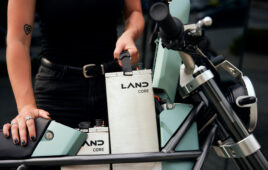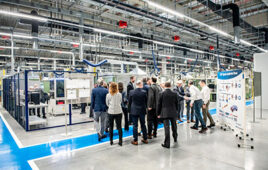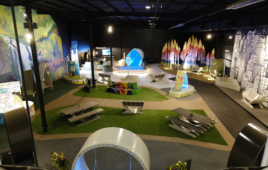By Rick Meyerhoefer, Delta Computer Systems
Roughly 3% of the world’s generated electricity is consumed in the mining process of breaking down rocks. In Canada alone, mines consume more than 150 petajoules annually. For perspective, 1 petajoule can power the city of Calgary for three weeks, so any significant drop in mining energy requirements could have vastly beneficial consequences, both in cost and environmental impact. Natural Resources Canada figured the problem was worth exploring and announced the Impact Canada Crush It! Challenge, urging applicants to develop “a new clean technology solution that transforms how energy is used for crushing and grinding rocks in the mining industry.” Cliff Edwards of Envisioning Labs has what he thinks is a winning idea; using high-pressure and temperature control to pulverize rock with supercritical CO2.
The core idea is that breaking rocks through compression is hard; breaking them with tension is far easier. Think about the difference in effort between squeezing a sealed soda can until it bursts compared to simply putting it in the freezer. The U.S. Bureau of Mines had experimented with rock comminution (breaking something down into smaller particles) through steam flashing in the 1930s. Like so many other approaches, though, this may have been discarded because the energy required for the process was too great relative to the results. But Edwards wondered if another fluid might be amenable to a lower-energy approach.
CO2 seemed like a strong contender. At a relatively easy-to-achieve 74 bar and 31° C, the substance transitions from a subcritical to a supercritical fluid. At this point, small changes in temperature and pressure can cause large changes in density and thus, volume. In theory, rocks could be bathed in supercritical CO2, allowing the substance to permeate the rocks’ pores, and then depressurized quickly enough to make the CO2 go subcritical and suddenly expand, bursting the rocks from within. Edwards relates the approach to explosives blasting used in mining to liberate rock from the ground, where rapid expansion of gasses from within the rock causes relatively efficient breakage.
He was confident the technology could work for the application. Unfortunately, an apparatus to put the idea into practice didn’t exist.
From collaboration to execution
Edwards reached out to MistyWest, a Vancouver, B.C.-based engineering design consultancy, which tapped project manager and mechanical engineer Cole Crocker to be the project’s tech lead.
“There was a lot of learning,” said Crocker. “I would go and investigate the thermodynamics and decide whether to use liquid CO2 versus filling it with gaseous CO2 in order to reach supercritical. In the early stages, we would do quick tests and learn something, then go iterate on that. Our entire first phase was just reaching a minimum viable experiment.”
 That first tabletop device was only 2-ft long and highly manual, essentially two pressure cylinders piped together with a central rupture disc and manual valves — but it worked. In one cycle, the device turned roughly 100 grams of rock into smaller rocks and dust. One more cycle resulted in nothing but micron-sized powder. The team was stunned with their success. The challenge became how to scale it.
That first tabletop device was only 2-ft long and highly manual, essentially two pressure cylinders piped together with a central rupture disc and manual valves — but it worked. In one cycle, the device turned roughly 100 grams of rock into smaller rocks and dust. One more cycle resulted in nothing but micron-sized powder. The team was stunned with their success. The challenge became how to scale it.
MistyWest contacted Vancouver, B.C.-based PQ Systems, a motion control solutions specialist, for help. PQ Systems recommended a novel implementation of a known design, a dual-section cylinder, and worked with Westcoast Cylinders to design. Essentially, there are two cylinders joined through a shared center head with a common rod and a piston on each end of that rod. One side is hydraulic and contains an MTS SSI Temposonics transducer for determining piston position. The other side compresses CO2 and has another transducer for monitoring pressure. PQ Systems decided the optimal motion controller for the system was Delta Computer Systems’ RMC75E.
Pulverization in practice
 The operation is deceptively slow and simple, moving less than one gallon of CO2 per minute. A valve on the CO2 side controls the inflow of CO2 from the supply tank to the secondary chamber (pressure vessel B, or “PVb,” above) as needed and seals shut before compression begins. As the piston in the hydraulic cylinder (HC-1) side extends over a period of 2-4 minutes, the CO2 is compressed into the supercritical pressure regime, sealed into the primary chamber by closing a fast-acting valve, and held there for 10-30 minutes. Because compressing gas can heat it substantially, a separate temperature probe makes sure that the system stays within allowed limits. The Delta controller retracts the shared rod to a given position, and finally the valve releases, allowing the gas to expand back into the secondary chamber and complete the cycle. Additionally, the RMC75E is responsible for finely controlling pressure levels in the face of fluctuating pressure conditions in a way that won’t incur excessive heat generation.
The operation is deceptively slow and simple, moving less than one gallon of CO2 per minute. A valve on the CO2 side controls the inflow of CO2 from the supply tank to the secondary chamber (pressure vessel B, or “PVb,” above) as needed and seals shut before compression begins. As the piston in the hydraulic cylinder (HC-1) side extends over a period of 2-4 minutes, the CO2 is compressed into the supercritical pressure regime, sealed into the primary chamber by closing a fast-acting valve, and held there for 10-30 minutes. Because compressing gas can heat it substantially, a separate temperature probe makes sure that the system stays within allowed limits. The Delta controller retracts the shared rod to a given position, and finally the valve releases, allowing the gas to expand back into the secondary chamber and complete the cycle. Additionally, the RMC75E is responsible for finely controlling pressure levels in the face of fluctuating pressure conditions in a way that won’t incur excessive heat generation.
 The second-generation cylinder measured 80-in. long with a 6-in. bore on each cylinder side, with each side allowing a 30-in. stroke. The whole assembly stands 10-ft tall. The pulverizer system can accept 1-2 kilograms of rock and 1-2 liters of CO2 in its primary chamber. Note that the primary chamber is not shown in the above image. Rather, it connects via pipes and valves to the hole in the bottom of the CO2 cylinder. The rock loads into the primary pressure chamber. In effect, the CO2 cylinder is dual-purpose, serving as both a compression device for pushing CO2 into the primary chamber as well as a collection tank for expansion of CO2 from that chamber.
The second-generation cylinder measured 80-in. long with a 6-in. bore on each cylinder side, with each side allowing a 30-in. stroke. The whole assembly stands 10-ft tall. The pulverizer system can accept 1-2 kilograms of rock and 1-2 liters of CO2 in its primary chamber. Note that the primary chamber is not shown in the above image. Rather, it connects via pipes and valves to the hole in the bottom of the CO2 cylinder. The rock loads into the primary pressure chamber. In effect, the CO2 cylinder is dual-purpose, serving as both a compression device for pushing CO2 into the primary chamber as well as a collection tank for expansion of CO2 from that chamber.
The motion controller’s role in this system is key, as the volume of the compression chamber is central to managing the pulverization process. Interestingly, the Delta controller works from a feedback loop based on the CO2 pressure rather than hydraulic pressure, which is unconventional. The system flows hydraulic fluid until the desired CO2 pressure is reached. The decompression stage resets the CO2 chamber back to a set point based on a target system volume.
“The Delta is doing two things,” said Misty West’s Cole Crocker. “It’s compressing the fluid into the primary chamber with the rock, and that will involve feedback from pressure. We close off the primary chamber valve and back off the piston in the secondary CO2 chamber using position feedback. Exactly how far we retract it is important because we need to know the volume of our secondary chamber, as that determines the resulting pressure after decompression. So, the Delta is controlling the pressurization as well as the retracted volume. We need to be able to make fine adjustments during compression while knowing we have retracted to the correct volume in preparation for decompression.”
 PQ Systems technical sales rep Robert de Rot recommended the single-axis Delta RMC75E, which offers a USB link for communicating to a Windows-based PC running Delta’s RMCTools software and Ethernet for communication with the PLC and HMI. PQ Systems points out that RMCTools plays an important role in the pulverizer solution, as “the software is quick to learn and offers capabilities such as the dual-loop position-pressure controls and the ability to quickly transition from position to pressure control all in a one-millisecond control loop,” which can greatly aid this application. The control loop can be shortened even further, to 0.5, 0.25, or even 0.125 millisecond if faster response is needed. The RMC75E uses Delta’s AP2 and D8 expansion modules for input and output. The AP2 module allows the RMC75 to perform differential position-pressure control with two 16-bit analog inputs and output a control signal to the Moog servo valve. The D8 module provides eight discrete I/O links individually configurable for greater flexibility, helpful in a prototype proof of concept such as this. The RMC75 can accept up to four of these expansion modules.
PQ Systems technical sales rep Robert de Rot recommended the single-axis Delta RMC75E, which offers a USB link for communicating to a Windows-based PC running Delta’s RMCTools software and Ethernet for communication with the PLC and HMI. PQ Systems points out that RMCTools plays an important role in the pulverizer solution, as “the software is quick to learn and offers capabilities such as the dual-loop position-pressure controls and the ability to quickly transition from position to pressure control all in a one-millisecond control loop,” which can greatly aid this application. The control loop can be shortened even further, to 0.5, 0.25, or even 0.125 millisecond if faster response is needed. The RMC75E uses Delta’s AP2 and D8 expansion modules for input and output. The AP2 module allows the RMC75 to perform differential position-pressure control with two 16-bit analog inputs and output a control signal to the Moog servo valve. The D8 module provides eight discrete I/O links individually configurable for greater flexibility, helpful in a prototype proof of concept such as this. The RMC75 can accept up to four of these expansion modules.
Crushing future challenges
Natural Resources Canada’s Impact Canada Crush It! Challenge mandated an energy reduction goal of at least 20%. Envisioning Labs estimates that its CO2 pulverization system achieves at least a 24% energy reduction compared to conventional crushing systems, although fine tuning continues to find the exact CO2 state that will yield optimal rock permeation and expansion fracturing. Once those numbers prove out, Edwards expects the mining industry to get involved. Envisioning Labs has already taken out a provisional patent on the approach, which could be applied to produce anything from smaller rocks to fine powder depending on the need. The system architecture would change at larger scales, but the underlying process would remain.
“The primary application here is to replace typical ball mill or SAG mill grinding in a mine’s comminution circuit,” said Cliff Edwards. “Secondary applications may include the cement industry, where they have to crush and grind limestone. It may also have application in aggregate or recycling industries.”
Edwards hopes that demonstrating the technology at scale in the near future will warrant a pilot plant within the next two years, which would then provide a model for the industry to follow.
Delta Computer Systems
www.deltamotion.com
Filed Under: Green engineering • renewable energy • sustainability, Controls




